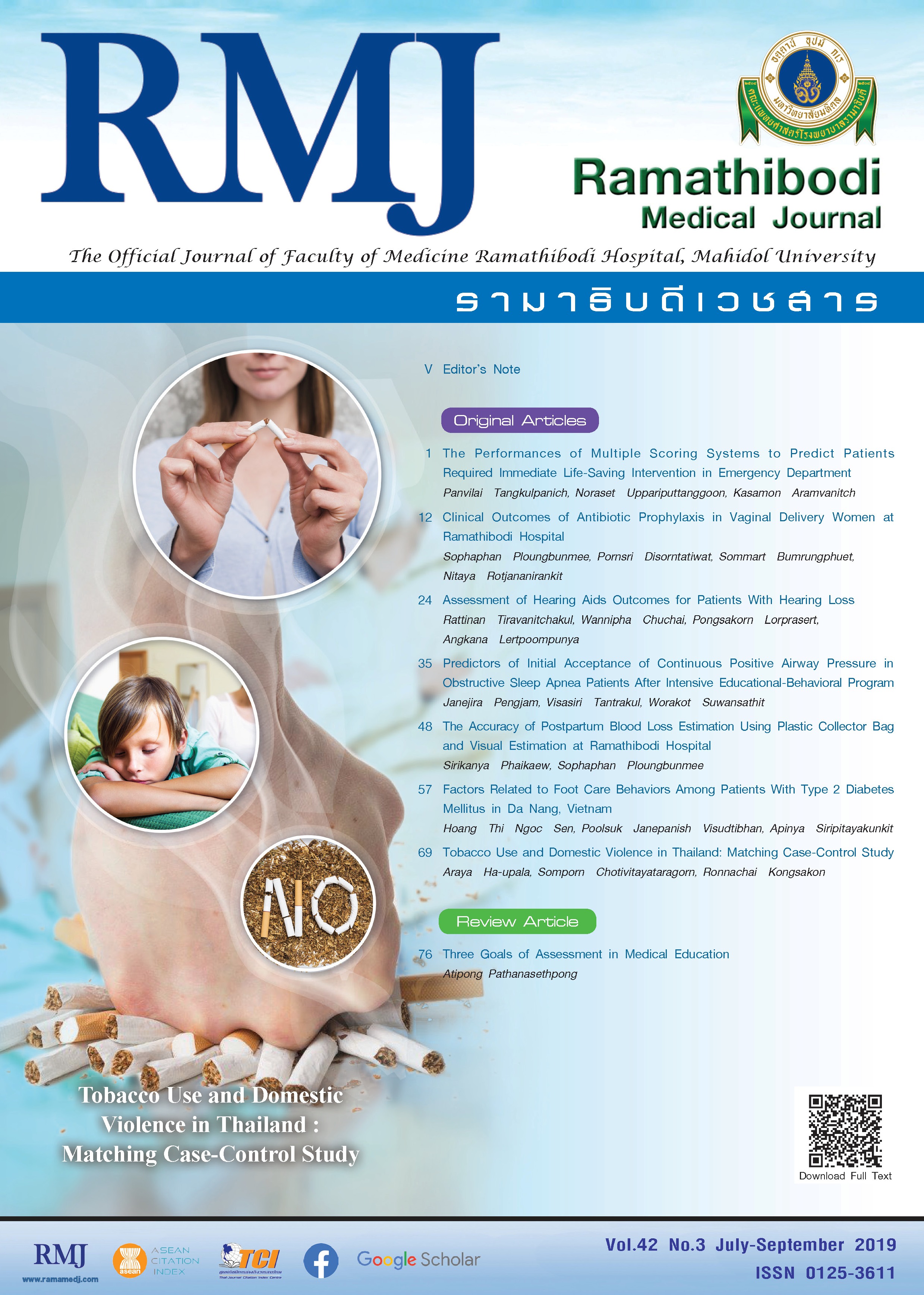Clinical Outcomes of Antibiotic Prophylaxis in Vaginal Delivery Women at Ramathibodi Hospital
DOI:
https://doi.org/10.33165/rmj.2019.42.3.168822Keywords:
Rational drug use, Antibiotic, Vaginal deliveryAbstract
Background: The rate of antibiotic use of vaginal delivery women in Ramathibodi Hospital is higher than expected standard criteria. The obstetrician team has developed clinical practice guidelines for rational drug use in antibiotic prophylaxis in vaginal delivery women.
Objectives: To examine the relationships among the percentage of using antibiotic prophylaxis, the prevalence of rational drug use and the prevalence of the episiotomy wound infection rate in vaginal delivery women before and after using the clinical practice guidelines for antibiotic prophylaxis.
Methods: The sample consisted of 983 vaginal delivery women who did not in the practice guidelines and 914 joined in practice guidelines groups. The rate of antibiotic use and episiotomy wound infection were collected before and after using the clinical practice guidelines for antibiotic prophylaxis. Data were analyzed by chi-square statistics.
Results: The rate of antibiotic use in vaginal delivery women is significantly related to the use of the practice guidelines (P < .01), which is reduced from 25.43% to 9.85%. The prevalence of rational drug use increased from 12.40% to 34.44%. The prevalence of episiotomy wound infection of women vaginal birth before and after using the practice guidelines was not significantly different (P = .96). There was no episiotomy wound infection in both groups.
Conclusions: The clinical practice guidelines reduces antibiotic use in postpartum women without episiotomy wound infection and promotes rational drug use.
References
National Antimicrobial Resistance Surveillance Center, Thailand, (NARST). Antibiotic resistance in Thailand. http://narst.dmsc.moph.go.th/news001.html. Published March 24, 2013. Accessed March 29, 2019.
Reasonable drug promotion subcommittee. Operation Manual of the Hospital Promotion Project Reasonable drug use. HRH Princess Maha Chakri Sirindhorn Medical Center; 2015. http://drug.fda.moph.go.th/zone_admin/files/RDU%20final_220615.pdf. Accessed March 29, 2019.
Sharma M, Sanneving L, Mahadik K, Santacatterina M, Dhaneria S, Stålsby Lundborg C. Antibiotic prescribing in women during and after delivery in a non-teaching, tertiary care hospital in Ujjain, India: a prospective cross-sectional study. J Pharm Policy Pract. 2013;6:9. doi:10.1186/2052-3211-6-9.
Say L, Chou D, Gemmill A, et al. Global cause of maternal death: a WHO Systemic analysis. Lancet Glob Health. 2014;2(6): e323-e333. doi:10.1016/S2214-109X(14)70227-X.
Gabbe SG, Niebyl JR, Simpson JL. Obstetrics: Normal and Problem Pregnancies. 6th ed. Philadelphia, PA: Elsevier Saunders; 2012.
Axelsson D, Blomberg M. Prevalence of postpartum infections: a population-based observational study. Acta Obstet Gynecol Scand. 2014;93(10):1065-1068. doi:10.1111/aogs.12455.
Ngoc NT, Sloan NL, Thach TS, Liem le KB, Winikoff B. Incidence of postpartum infection after vaginal delivery in Viet Nam. J Health Popul Nutr. 2005;23(2):121-130.
American College of Obstetricians and Gynecologists. ACOG Practice Bulletin No. 120: use of prophylactic antibiotics in labor and delivery. Obstet Gynecol. 2011;117(6):1472-1483. doi:10.1097/AOG.0b013e3182238c31.
Bonet M, Ota E, Chibueze CE, Oladapo OT. Routine antibiotic prophylaxis after normal vaginal birth for reducing maternal infectious morbidity. Cochrane Database Syst Rev. 2017;11:CD012137. doi:10.1002/14651858.CD012137.pub2.
Poovarodom U. Appropriate use of antibiotics in Ranong province: a stepwise approach to rational drug use. JPMAT. 2018;8(3):421-429.
Liabsuetrakul T, Choobun T, Peeyananjarassri K, Islam QM. Antibiotic prophylaxis for operative vaginal delivery. Cochrane Database Syst Rev. 2017;8:CD004455. doi:10.1002/14651858.CD004455.pub4.
Chawanpaiboon S. Preterm Labor. Bangkok: PA Living; 2010.
Ruangdejnarong H, Thongsong T. Update in Preterm labor. http://www.med.cmu.ac.th/dept/obgyn/2011/index.php?option=com_content&view=article&id=1265:update-in-preterm-labor&catid=45&Itemid=561. Update August 21, 2016. Accessed March 29, 2019.
Mayor S. Antibiotics are recommended in preterm labour to stop group B streptococcal transmission. BMJ. 2017;358:j4271. doi:10.1136/bmj.j4271.
King J, Flenady V. Prophylactic antibiotics for inhibiting preterm labour with intact membranes. Cochrane Database Syst Rev. 2002;(4):CD000246. doi:10.1002/14651858.CD000246.
Kenyon S, Boulvain M, Neilson JP. Antibiotics for preterm rupture of membrane. Cochrane Database Syst Rev. 2013;(12):CD001058. doi:10.1002/14651858.CD001058.pub3.
Suntharasaj T. Clinical Practice Guideline by the Royal Thai College of Obstetricians and Gynaecologists 2007-2012. Bangkok: The Royal Thai College of Obstetricians and Gynaecologists; 2012.
Chhabra S, Dhorey M. Retained placenta continues to be fatal but frequency can be reduced. J Obstet Gynaecol. 2002;22(6):630-633. doi:10.1080/0144361021000020402.
Chongsomchai C, Lumbiganon P, Laopaiboon M. Prophylactic antibiotics for manual removal of retained placenta in vaginal birth. Cochrane Database Syst Rev. 2014;(10):CD004904. doi:10.1002/14651858.CD004904.pub3.
Chibueze EC, Parsons AJ, Ota E, Swa T, Oladapo OT, Mori R. Prophylactic antibiotics for manual removal of retained placenta during vaginal birth: a systematic review of observational studies and meta-analysis. BMC Pregnancy Childbirth. 2015;15:313. doi:10.1186/s12884-015-0752-4.
Knight M, Mottram L, Gray S, Partlett C, Juszczak E, ANODE collaborative group. Prophylactic antibiotics for the prevention of infection following operative vaginal delivery (ANODE): study protocol for a randomised controlled trial. Trials. 2018;19(1):395. doi:10.1186/s13063-018-2787-0.
van Schalkwyk J, Van Eyk N. Antibiotic prophylaxis in obstetric procedures. J Obstet Gynaecol Can. 2010;32(9):878-884. doi:10.1016/S1701-2163(16)34662-X.
Duggal N, Mercado C, Daniels K, Bujor A, Caughey AB, El-Sayed YY. Antibiotic prophylaxis for prevention of postpartum perineal wound complications: a randomized controlled trial. Obstet Gynecol. 2008;111(6):1268-1273. doi:10.1097/AOG.0b013e31816de8ad.
Buppasiri P, Lumbiganon P, Thinkhamrop J, Thinkhamrop B. Antibiotic prophylaxis for third- and fourth- degree perineal tear during vaginal birth. Cochrane Database Syst Rev. 2010;(11):CD005125. doi:10.1002/14651858.CD005125.pub3.
Nishimura RA, Otto CM, Bonow RO, et al. 2014 AHA/ACC guideline for the management of patients with valvular heart disease: executive summary: a report of the American College of Cardiology/American Heart Association Task Force on Practice Guidelines. Circulation. 2014;129(23):2440-2492. doi:10.1161/CIR.0000000000000029.
Yokoe DS, Christiansen CL, Johnson R, et al. Epidemiology of and surveillance for postpartum infections. Emerg Infect Dis. 2001;7(5):837-841. doi:10.3201/eid0705.010511.

















